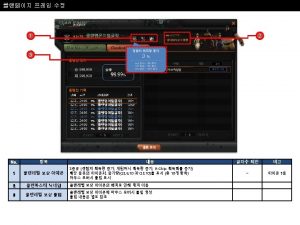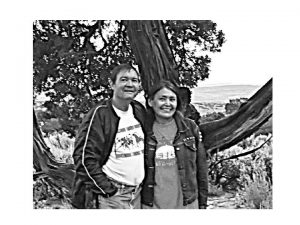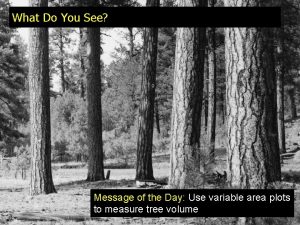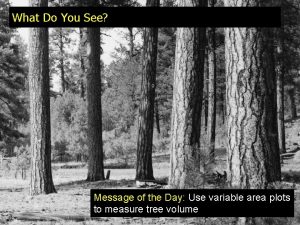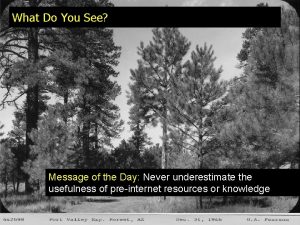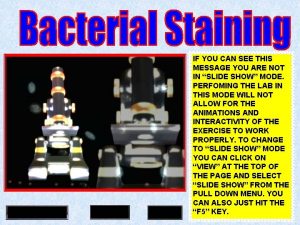What Do You See Message of the Day










































- Slides: 42

What Do You See? Message of the Day: Even when using the correct equipment, unforeseen errors may occur

FOR 274: Forest Measurements and Inventory Measures of Stem Diameter • Diameter at Breast Height • Diameter at Root Collar

Diameter at Breast Height: Introduction DBH is outside bark diameter at 4. 5 feet above the forest floor on the uphill side of the tree. The forest floor includes the duff layer that may be present, but does not include unincorporated woody debris that may rise above the ground line. If a dead tree (snag) is missing bark, measure the DBH without the bark and record that measurement.

Diameter at Breast Height: Introduction Why 4. 5 Feet? • A convenient height for people to measure • Most models of forest growth and yield assume measurement at this height • A commonly accepted standard

Diameter at Breast Height: Measurement Tools Tapes: DBH and Loggers tapes Biltmore Stick Calipers

Diameter at Breast Height: Using DBH Tapes rely on the calculation: Circumference = Pi * D (= 2*pi*r): The tapes are made so that wrapping the tape around a tree of a given circumference you can directly read off the tree’s diameter. How do we infer cross-sectional area?

Diameter at Breast Height: Using DBH Tapes DBH is one of the most common forest measurements that you will make In forestry we use the tape such that the “ 0” mark is below the main tape

Diameter at Breast Height: Using DBH Tapes When using (as you will later), press the tape firmly against the tree: Do not pull it out at an tangent just before the measurement!

Diameter at Breast Height: Using DBH Tapes To reduce errors make sure the numbers are read the correct way up. Numbers should be rounded down to the nearest 1/10 th inch.

Diameter at Breast Height: Using Relaskops The viewable bar widths in the relakskop can be used to estimate diameter at set distances from the tree. Per 33’ small bar pairs represent 2” and large bar pairs represent 12”.

Diameter at Breast Height: Using Relaskops

Diameter at Breast Height: Using Relaskops Example: Tree is 1 chain from cruiser – what is it’s diameter? Answer: 24” DBH

Diameter at Breast Height: What would you do here?

Diameter at Breast Height: Sloping Ground and Trees

Diameter at Breast Height: What would you do here?

Diameter at Breast Height: Using DBH Tapes

Diameter at Breast Height: Using DBH Tapes For cankers occurring at DBH you can either measure as close as possible above and account for taper OR take an average above and below.

Diameter at Breast Height: Using DBH Tapes

Diameter at Breast Height: What would you do here?

Diameter at Breast Height: What would you do here?

Diameter at Breast Height: What would you do here?

Diameter at Breast Height: What would you do here? For trees growing on objects (rocks, logs, etc), the DBH is measured by assuming the tree’s base is at the root crown.

Diameter at Breast Height: What would you do here?

Diameter at Breast Height: What would you do here?

Diameter at Breast Height: What would you do here? This measure of DBH depends on: 1. Is the junction above 4. 5 feet? 2. Is the junction a fork or a branch?

Diameter at Breast Height: Branches and Forks A fork in a tree is defined as: Where the stem is at least 1/3 the diameter of the main stem and must branch out from the main stem at an angle of 45 degrees or less. Forks originate at the point on the bole where the piths intersect.

Diameter at Breast Height: Branches and Forks When branches occur at 4. 5 feet: Measure the DBH on the main stem just above the branch

Diameter at Breast Height: Branches and Forks If fork occurs close to 4. 5 feet: IF you can see light between the two stems at DBH, we measure each stem as 2 separate trees IF you can see no light, we measure the combined DBH as one tree

Diameter at Breast Height: Branches and Forks Special Case: If two trees have grown together (as indicated by a bark seam above and below DBH), then each tree is measured separately.

Diameter at Breast Height: Branches and Forks If fork occurs above 4. 5 feet: When trees are forked at 4. 5 feet or higher we record only one tree and measure the main fork. Be sure to measure DBH below the swell of the fork!

Diameter at Breast Height: Branches and Forks If fork occurs below 4. 5 feet: We measure each fork as a separate tree and measure both diameters at 4. 5 feet

Bark: Diameter Inside Bark (DIB) Measurement Form Class describes a set of methods to estimate the top diameter of the first log. This diameter is needed as it will effect all subsequent log diameters and thus the merchantable volume. A common Form Class is the ratio of diameter inside bark (DIB) at the top of the first log to the DBH. This ratio captures the taper that occurs during the first log. The Bark Thickness Ratio (BTR) is the ratio of the DIB to the diameter outside bark (DOB) at the top of the first log. FC = (DIB/DBH)*100 = (22/30)*100 = 73

Bark: Diameter Inside Bark (DIB) Measurement Using Bark Gauges: Bark thickness is measured with a small chisel that has a movable scale Once you “feel” the chisel change in pressure as you hit the wood under the bark you measure the scale

Bark: Measurement Using Bark Gauges: • Minimize any twisting of the gauge and the chisel tip is easily (and often!) broken • For trees with rough bark – measure thickness on ridges • Repeat several times around stem to get average measurement • If measuring DBH, use gauge at same height

Diameter at Breast Height: What would you do here?

Diameter at Root Collar: Introduction Diameter at Root Collar (DRC) is the diameter measured at the root collar or at the natural ground line, whichever is higher, outside the bark. Measure tree stems only, not branches. A stem generally grows in an upright position and contributes to the main structural support of a tree crown.

Diameter at Root Collar: Introduction Shrubs and multi-stemmed trees: • DRC is equal to the square root of the sum of the squared stem diameters • For a single-stemmed tree, DRC is equal to the single diameter • For a multi-stemmed tree, DRC is calculated from the diameter measurements of all qualifying stems (≥ 1. 5" diameter and at least one foot in length).

Diameter at Root Collar: Introduction

Diameter at Root Collar: Introduction DRC should be measured as close to the ground as possible

Diameter at Root Collar: What would we do here?

Diameter at Root Collar: What would we do here?

Extra Credit Question (due Monday) Describe different sources of error when measuring dbh with a diameter tape, a caliper, or a Biltmore stick?
 Day 1 day 2 day 3 day 4
Day 1 day 2 day 3 day 4 Day 1 day 2 day 817
Day 1 day 2 day 817 See you again have a nice day
See you again have a nice day It's not what you look at that matters, it's what you see.
It's not what you look at that matters, it's what you see. If you could see the future what would you do
If you could see the future what would you do Good morning i am fine
Good morning i am fine Good morning good morning good afternoon
Good morning good morning good afternoon What you see is what you get
What you see is what you get She worked hard. she made herself ill
She worked hard. she made herself ill شرح قصيدة count that day lost بالعربي
شرح قصيدة count that day lost بالعربي Count the day lost questions
Count the day lost questions Schoolmax gradebook
Schoolmax gradebook Oceans apart day after
Oceans apart day after Day to day maintenance
Day to day maintenance As your room gets messier day by day, entropy is
As your room gets messier day by day, entropy is I don't know about tomorrow i just live from day to day
I don't know about tomorrow i just live from day to day Timeline of romeo and juliet
Timeline of romeo and juliet Growing day by day
Growing day by day Seed germination inhibitors examples
Seed germination inhibitors examples Conclusion of seeds
Conclusion of seeds Seeds vs spores
Seeds vs spores I live for jesus day after day
I live for jesus day after day One day he's coming oh glorious day
One day he's coming oh glorious day Day one day one noodle ss2
Day one day one noodle ss2 Tactique futsal
Tactique futsal Hình ảnh bộ gõ cơ thể búng tay
Hình ảnh bộ gõ cơ thể búng tay Lp html
Lp html Bổ thể
Bổ thể Tỉ lệ cơ thể trẻ em
Tỉ lệ cơ thể trẻ em Voi kéo gỗ như thế nào
Voi kéo gỗ như thế nào Thang điểm glasgow
Thang điểm glasgow Hát lên người ơi alleluia
Hát lên người ơi alleluia Các môn thể thao bắt đầu bằng tiếng đua
Các môn thể thao bắt đầu bằng tiếng đua Thế nào là hệ số cao nhất
Thế nào là hệ số cao nhất Các châu lục và đại dương trên thế giới
Các châu lục và đại dương trên thế giới Công của trọng lực
Công của trọng lực Trời xanh đây là của chúng ta thể thơ
Trời xanh đây là của chúng ta thể thơ Cách giải mật thư tọa độ
Cách giải mật thư tọa độ Phép trừ bù
Phép trừ bù độ dài liên kết
độ dài liên kết Các châu lục và đại dương trên thế giới
Các châu lục và đại dương trên thế giới Thơ thất ngôn tứ tuyệt đường luật
Thơ thất ngôn tứ tuyệt đường luật Quá trình desamine hóa có thể tạo ra
Quá trình desamine hóa có thể tạo ra














































